
Being several months since my last blog post, it’s been quite some time since I’ve given any updates. Things have been very eventful since my last writing. While it has all been great fun, it’s left me with little time to do much writing. Since the arrival of winter proper, I’ve been connecting closer with my friends and getting more involved in activities outside of my work life. While I’m left quite exhausted at the end of each day, I’m having a great time. As I mentioned at the end of my previous entry, I had started journaling my daily events to help keep track of all the things I’ve been doing. I’m happy to say that I am still keeping this up. This should make it much easier to recall all that’s happened since. Without any more delay, let’s get right into it!
November
November started off with my choice to recontract for another year on the JET program. While it seems quite fast to have to make a decision so soon after arriving, the process for the next batch of applicants to the JET program had already started. It took only a few weeks of teaching to decide that I wanted to continue doing this for longer than just one year.
A few new things started this month. First, at the request of one of my favorite teachers, I agreed to help her friend by offering English conversation practice. I met with Ryoko for the first time early in the month. She is a nice older lady, who enjoys traveling, the outdoors and classical music. We got along really well right away. I currently meet with her every other week at a café where we have conversation practice. We have a lot in common, and she’s a pleasure to speak with. I also began trying out Kyudo, or Japanese archery. A close friend of mine, Kathy, is very passionate about it and was looking for anyone interested in joining. I accepted, along with some others, having had experience with and enjoyed western archery and an interest in at least trying Kyudo. The people at the Dojo are really nice, Enomoto sensei helped get us started. The first session didn’t involve even holding a bow. The focus of Kyudo, unlike western archery, has a lot more to do with the technique and form. Hitting the target is far less important than in western archery. It is implied that if your form is perfect, you will hit the target easily. Kyudo takes years of practice and instruction. Learning about and experiencing Kyudo has been really gratifying so far, and I have a strong appreciation for just how much it takes.
It was around now that we started to see our first snow. Sapporo is considered one of the snowiest cities in the world, and I was interested in seeing just how that might manifest. At this point, nothing was really sticking, but it made me excited for the cooler weather to come. About halfway through the month, some friends and I rented a car and headed drove outside of town for an Onsen trip. Our destination was Hoheikyo, a popular spot about an hour ride south. Hoheikyo was an interesting one, being as it was probably most well known for its Indian curry served at the restaurant there, with “Curry” appearing in Google reviews more than “Onsen”. Sure enough, the first thing we did after arriving was line up for a curry lunch. I opted for the chicken curry, which came with a large naan. I opted for the spiciest level, which in reality wasn’t all that spicy. Still, it was really delicious. After lunch, we all hit the Onsen. It was quite nostalgic, having been ages since I last went to one. I went with the other guys to the men’s bath, where we spent most of the time in the outdoor bath, chatting and enjoying the warm water and cool air. After we finished bathing, we met with the others and headed back to Sapporo in time to return our rental car. It was a wonderful trip.
We had a meeting of the History club I had mentioned in my last post the week following the Onsen trip. This time I had prepared a long presentation about the history of Sapporo beer, based on a book I was reading at the time. It talked about the figures, places and drama around the founding of the brewery. The story was really more interesting than I figured it would be, and I greatly enjoyed doing the research and presenting it. The following Sunday, I met up with the group from the history club for a field trip to the beer museum. I ran them through the exhibits and added some more information where I could. At the end, we all went to the tasting hall and sampled a flight of beers from the museum.
November was also the month that I managed to assemble a group of people to play Mahjong with. I had been looking for people who were interested a bit before, and finally managed to find a full group of people to play with. The first session was simple and slow, allowing everyone time to be taught the game. The next session allowed us to get right into it, albeit still at a slower pace. We would have semiregular games, with a pool of 5 other people, making it easy to find at least 4 people for a game at any given time.

December
December started off strong with a Christmas party I was invited to join by Enomoto sensei the month prior. We were invited first over to his apartment for lunch and tea, which was wonderful. Afterward, we all headed into the city for the Christmas party. It was organized by an international group connecting foreign residents with natives in Sapporo. There were both Japanese people as well as others from places like China, Korea and others. There were various games such as a spoon race and a rock paper scissors competition. The rest of the afternoon included dancing, matcha and a speech wishing everyone good wishes. We all went out for tea after the party. It was a lot of fun to meet some new people outside of my circles.
In December, I decided to start wearing a Santa hat in school for the entire month. This was a big hit and I got good words from both the students and the teachers. I also started attending the Japanese club, a weekly meeting of other Sapporo JETs where we study, exchange tips and review grammar together. The club also includes monthly movie sessions where we watch movies in Japanese together and take breaks to discuss. While quite a few of our activities go a bit over my head, we host a wide variety of levels and are good at accommodating everyone. I think everyone there gets something out of it. I’ve really enjoyed attending the meetings.
About halfway through the month we had a Christmas potluck, this time organized by me on behalf of the Ministry of Fun along with some other senior JETs, including the prefectural advisor for JETs in all of Hokkaido. This was organized to be open to far more people, including those outside of the Sapporo community. We had managed to work together to book a room in a local community center. We set up some tables and started welcoming people in. The turn-out was about 30 people, with about half of them being folks from outside of Sapporo. It was quite fun to meet and interact with some people outside the regular crowd. People brought a whole collection of interesting goodies including things like homemade bread, cookies, brownies and of course some more non-pastry stuff. The party lasted about two hours and ended with me and the other organizers saying some parting words. Being the only organizer to not be heading home right away, I took charge of organizing and leading the nijikai or after party. Being a group of about 15, it took a little bit to find a place that could host us all, but eventually, we did and enjoyed snacking, drinks and conversation for the rest of the evening.
In the theme of partying, the week after was the school’s Bonenkai, literally “forget the year gathering”. It’s the big end of the year party to forget the troubles of the year. Unlike the Nomikai from the last post, a Bonenkai is often a bit more formal and expensive. Ours had us meet in the basement of a hotel and included a full dinner and all you can drink, as usual for such parties. I arrived on the earlier side and was assigned a random seat at a random table. I got to sit with a few teachers I hadn’t had the chance to talk with until then, and we made great conversation. Coincidently, two other English teachers were assigned to the same table, though I spent most of my time talking with the teachers I don’t usually have the opportunity to speak with. There were a bunch of speeches, games and activities, few of which I fully got, but did my best to follow along as best I could. It was all a lot of fun.
Christmas Eve and Christmas day, on the contrary, were both pretty relaxed. Not being major holidays in Japan, I opted to work on both days. Christmas Eve was spent making eggnog with a friend and on Christmas Day I went to my regular Izakaya, where I hung out and talked with a nice Japanese woman for a few hours. Following all the events earlier on in the month, it was kind of nice to have some downtime.
The downtime didn’t last too long, since the winter vacation was now in full swing. After just two days of downtime, things began to pick right back up. Me and a bunch of other friends would be making our way down south to the National Ainu Museum. A museum about the native population of the island of Hokkaido, the Ainu. I had taken the liberty to start learning a bit of the language in anticipation of the trip in my spare time. There would be two other JETs from down south joining us and hanging out in Sapporo for the week. The thing was, the museum was about an hour drive down south, so we would be renting two cars. Being one of the few people with a valid license, I would be one of our drivers. I was pretty nervous, being that I would be driving on the left side of the road for the first time, in a foreign country, and in some pretty icy conditions.
Driving ended up being not too bad, once we got out of Sapporo, the ice was pretty much completely gone. With the steering column on the right side of the car, driving on the left side of the road was far easier than I had imagined. The biggest thing was mainly the indicators and wipers being swapped, resulting in me pretty consistently hitting my wipers at each intersection. All the same, we arrived at our destination after picking up one of the other JETs at the airport. Despite taking two routes, both cars managed to arrive at the museum within minutes of each other.

The museum itself was great, with many wonderful exhibits. There were a lot of things on display, from spears to textiles to ritual items and objects from day to day life. The museum did a great job of explaining the history and cultural issues stemming from the Japanese colonization of Hokkaido in the 19th century. There was also an outdoor village section of the museum that had some Ainu huts with various activities and events in each. I went to the one where you could try on some traditional Ainu clothing, which was a lot of fun. On the other side of the museum, there was also a traditional archery experience. For a bit of money, I was able to shoot at a foam deer with a bone-tipped arrow. It was cool learning about the importance of using poison in arrows culturally and how there was quite a bit of tension between the Ainu and the Japanese government after a law was passed banning the use of poison in hunting. We headed back to Sapporo just after the museum closed.
The last parts of the month included showing the visiting JETs around Sapporo and hanging out. New Year’s Eve included meeting up with a bunch of other friends and doing Hatsumode, or the first shrine visit of the year. We all went met up together at a shrine and gave shrine offerings. It was quite a bit calmer than the intense party that New Years is in the west, but I found myself really enjoying it.

January
The beginning of January was characterized primarily by shrine visits. Right after the visit and offering at the shrine, I went and got a Goshuin book. Goshuin are little honorific stamps that can be collected at shrines and temples. The most basic include some calligraphy, with some of the more intricate ones including colors, designs and even embroidery. The book bound like an accordion, with each page able to fit one stamp. I got my first stamp along with the book right after hatsumode. Collecting more Goshuin would be how I would spend the first few days, shrine hopping with a friend and gathering a good half dozen.

I would lie low and relax for a few days before catching a flight down to Tokyo to meet with a friend. James is from back in the US and was on the second stint of an Asia trip. He had just come back from about a week in Vietnam with his family. We had arranged to meet up and travel around for about a week. I met him in the hostel that we had booked for the night, and we headed over to Tokyo station to buy some Shinkansen tickets for the next day. We grabbed dinner and discussed the details and the tentative schedule we had come up with before. We had planned to head back up to Sapporo, making stops at various cities on our voyage north. The first destination would be Sendai, the next morning.
After waking up and checking out, we walked over to Tokyo station and dropped out bags in some luggage lockers before wandering around the area of the station while we waited for our train to depart. Following a brief visit to a nearby bookstore and a bit of lunch, we boarded the train for Sendai. We arrived in the city only a few hours later to an impressive amount of snow. Apparently, the first of the year thus far. We swung over to the hotel and dropped off our bags before heading back over to the main station and grabbing a bus. We went and visited a shine and explored a bit of the outskirts of the city. This was, of course, a good opportunity to collect some more Goshuin to add to my book. I remember how striking the difference in both the architecture and layout of the Sendai was in comparison to Sapporo. Having a history as a city nearly twice as long as Sapporo, it was cool to see how the two were different. After sundown, we headed back to the center city to get some dinner. The local delicacy in Sendai is Gyutan, or beef tongue. Having never thought to have beef tongue before, I was pretty unsure of what to expect. The dish was packed with flavor and expertly grilled. It would leave me thinking about it for several days after.
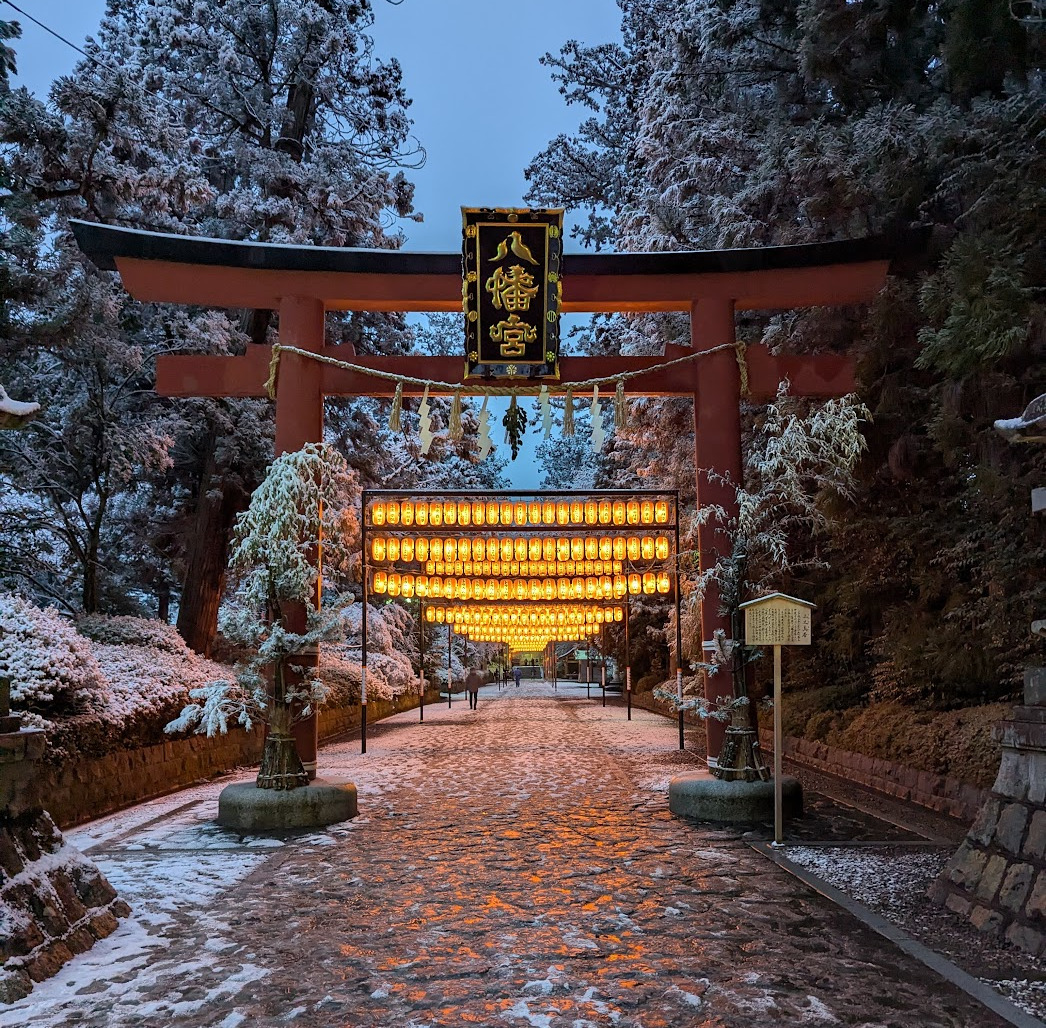
The next morning we checked out and dropped our bags in lockers at the station. We would be splitting up for the morning and meeting again for our afternoon train. I was to meet a friend of mine from high school, Olivia. She was one of the presidents of my high school Japanese club and had been living in Sendai as a teacher for a few years. We met up and went out for coffee. While it was fun to talk and catch up, it was strange talking with someone I hadn’t seen or spoken to in over seven years. We talked a lot about teaching, traveling, Japan in general and what we had been up to in the past few years. I even found out that her grandparents lived in the exact same town in Vermont that I had been living just before. I found out she would be leaving Japan in the spring, so it was a bit of a shame that we wouldn’t have a chance to meet up again, but it was nice that we managed it in the first place. After parting ways around noon, I met back up with James at the station, where we hopped on the train for our next location, Hakodate.

The next leg of our journey included the Hokkaido Shinkansen. While still well under construction, with the plan to eventually connect Sapporo to the northern tip of the main island, Honshu. Service was currently available as far as Hakodate. An important and historical port city on the southern tip of Hokkaido. The unique part of the route was the underwater portion beneath the Tsugaru Strait. While it was, of course, dark, it was cool to know I was traveling in a high-speed train about 100 meters below the seabed. We arrived at the Shinkansen station around sunset before hopping on a train into the city. We dropped our bags at the hotel we would be staying in and headed back out. Hakodate is situated on a pretty big peninsula, at the end of which is Mount Hakodate. This would be our destination for the evening. At the top of Mount Hakodate lies what is considered one of the best night views in all of Japan. We headed to the foot of the mountain and got on the rope way to the observation point. We spent some time up there enjoying the truly impressive view before heading back down, getting some dinner. Before turning in for the evening, we made a final stop at a Seicomart, the infamous Hokkaido only convenience store.
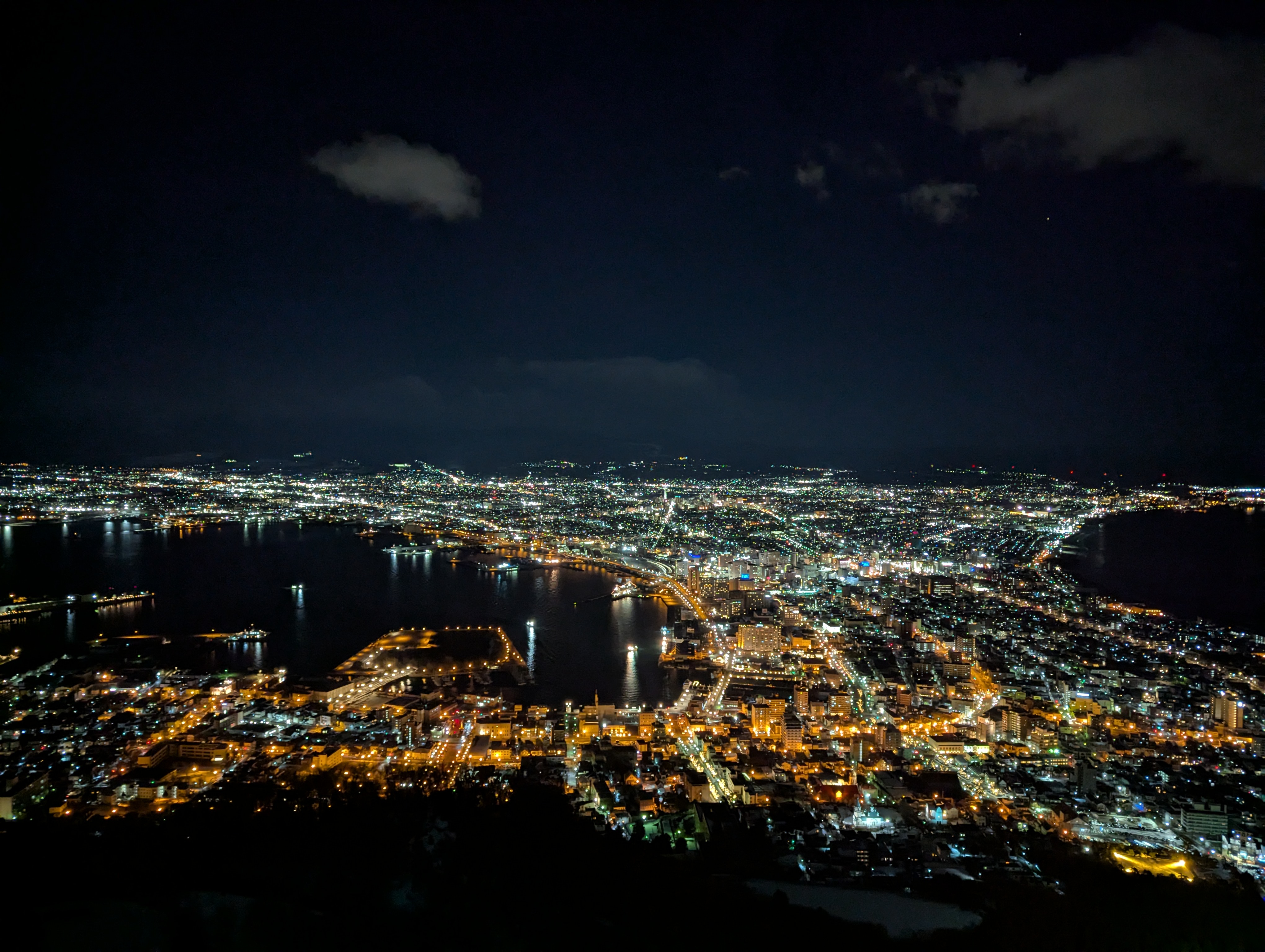
The next morning we checked out and dropped our bags in coin lockers at the station, as had become routine. We hopped on a tram over to Cape Tachimachi, a cape at the south end of the peninsula. The walk there provided excellent views of both the city, as well as Honshu, all the way across the strait. We walked back over towards the city, but on the way, made a stop at a small Buddhist temple hidden at the base of the mountain. This temple was one of the major bucket list items I had for our trip. When talking to my friend about Goshuin, she had mentioned an incredible looking one she had seen in someone else’s Goshuin book. When asking about it, she discovered it was from Hakodate, at the very temple I was heading towards this morning.
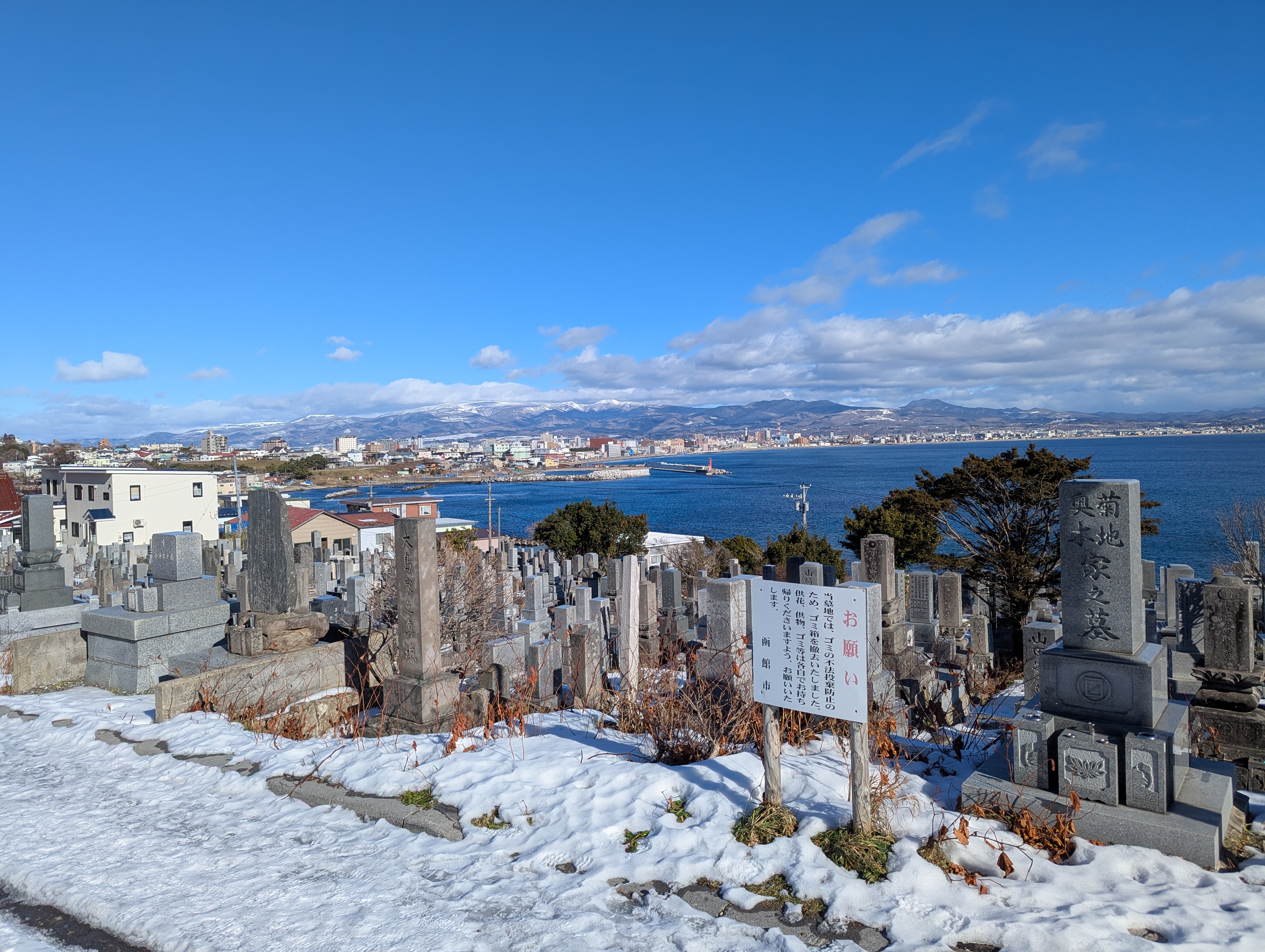
After entering reception, I waited for a bit before running into a woman. She apologized for keeping me waiting and took my Goshuin book to give to an older gentleman to fill in. She let me into the altar area to sit down. We talked a bit, she complimented me on my Japanese, asked me the questions I was used to, where I was from, where I was living, et cetera. I talked about being a teacher, and she mentioned how her daughter is a 3rd year in middle school. She asked if I wanted to see the main altar, which I, of course, said yes to. She led me through a small door at the back of the alter that lead up to the main temple. This was even more ornate than the one in the reception building. She took time to explain the deities of the altar. She then showed me the secondary shine that had a small Buddha with a sack. She explained how he carries a sack of people’s dissatisfactions and will smile to make them go away. She also showed me how holy texts had been manually copied across the back of the statue. She said there were just shy of 90,000 characters on it. I used a little bit of Hokkaido dialect, which made her laugh. After talking some more, the older gentleman came back with my Goshuin book and finished pages. I thanked them greatly. When I asked how much, she said it was free, but I asked if I could make a donation and she said yes. I left ¥2,000. She then offered to take my picture in front of the Buddha, I said, of course. She saw me to the door and I thanked them profusely.
After the temple, we spent the morning walking around the town. Being, historically, an important port for foreign trade, many of the building wouldn’t have looked out of place in an American or European city. James noted that many parts of the city looked like Annapolis, which was pretty on the nose. Finally, after walking around a good bit, we headed for the Goryokaku, a star fort that played a major role in the end of the Boshin War after the Meiji Restoration. I opted to pay to take the elevator up an observation tower to get a better view of the fort. The tower also had an incredible view of the surrounding city as well as Mount Hakodate. After enjoying the view, I met up with James, who had opted to take a walk around the grounds of the fort. We both made our way back to the station to grab our bags and catch a train to our next destination, Noboribetsu.
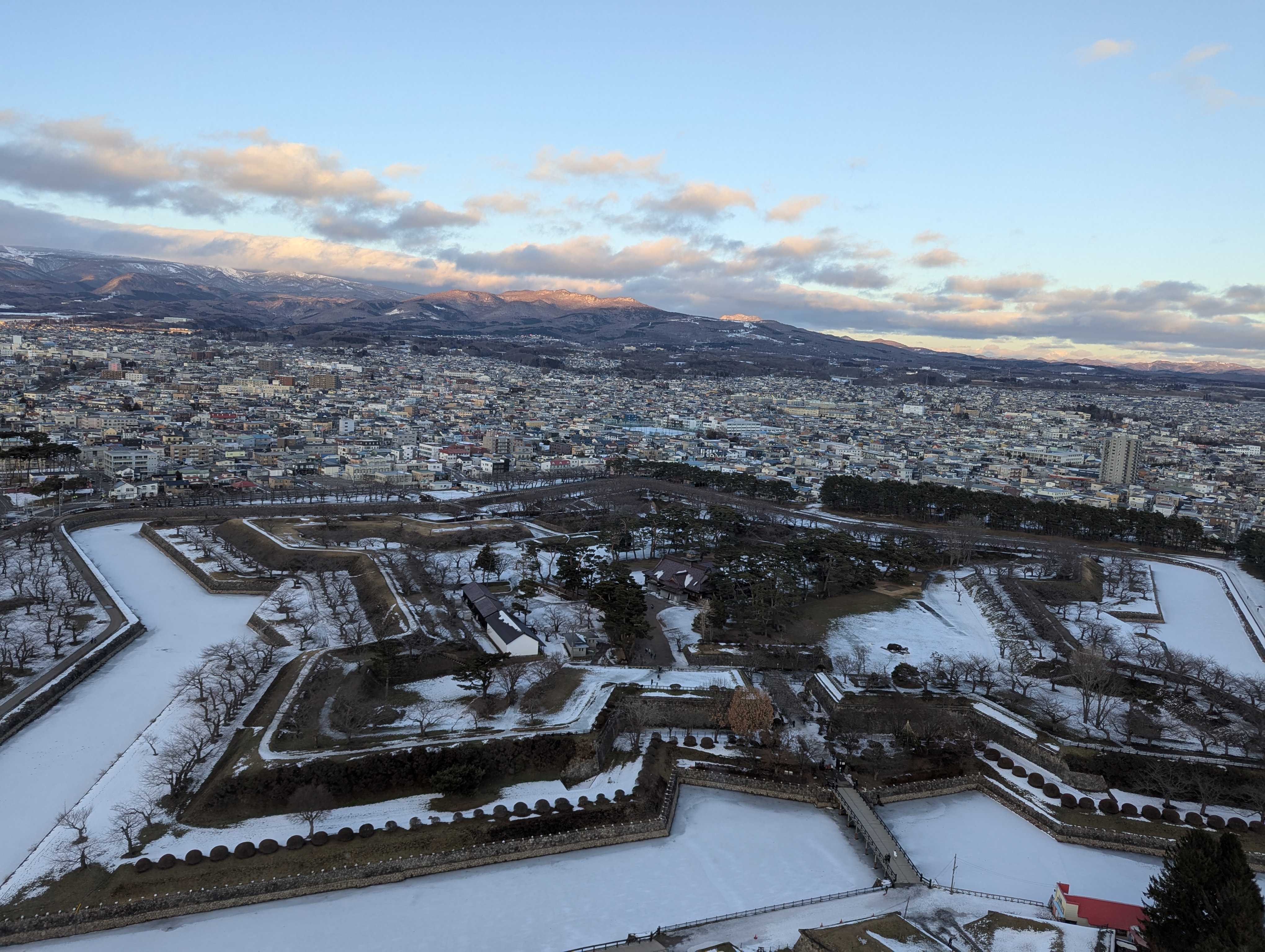
We rolled into Noboribetsu station about two hours later. Noboribetsu was a town famous for it’s hot springs, which was made evident from the strong scent of sulfur in the air after we disembarked. We made our way to our hostel and dropped off our stuff. Being restless, I went for a walk and stumbled accross a small bar to find some locals to talk with. There were only two people there, both who left shortly after. I had a nice conversation with the bartender about various things from wine, the Oktoberfest and Hokkaido in general. It’s strange how, compared to people in Tokyo or Sendai, I felt really comfortable talking with people in Hokkaido. I think it’s really becoming a place that feels more and more like home. I went for a walk to admire how bright the stars were before returning to the hostel and turning in for the evening.
We woke up early and grabbed some breakfast, dropping our bags in the station coin lockers as usual. We took the 20-minute bus ride up to Noboribetsu-onsen, the place where all the actual hot springs could be found. While Noboribetsu town was small and rural, Noboribetsu-onsen had several towering hotels nestled into the surrounding hills. We headed over for “Hell Valley”, the source of the onsen, a sulfur stained valley with plumes of steam emerging from the cracks in the ground. After exploring the valley, we turned back towards the town and made our way to Takimotokan, one of the baths, said to be the largest in Asia. We brought ourselves day passes and spent a few hours enjoying the baths. After we were satisfied, we dried off, hopped on the bus back to the station and boarded another bus bound for Sapporo. After getting into Sapporo, we split again. I dropped my stuff at my apartment and saw James to his hotel. I headed out to go meet some friends while James took a nap and spent the evening exploring some of Sapporo.
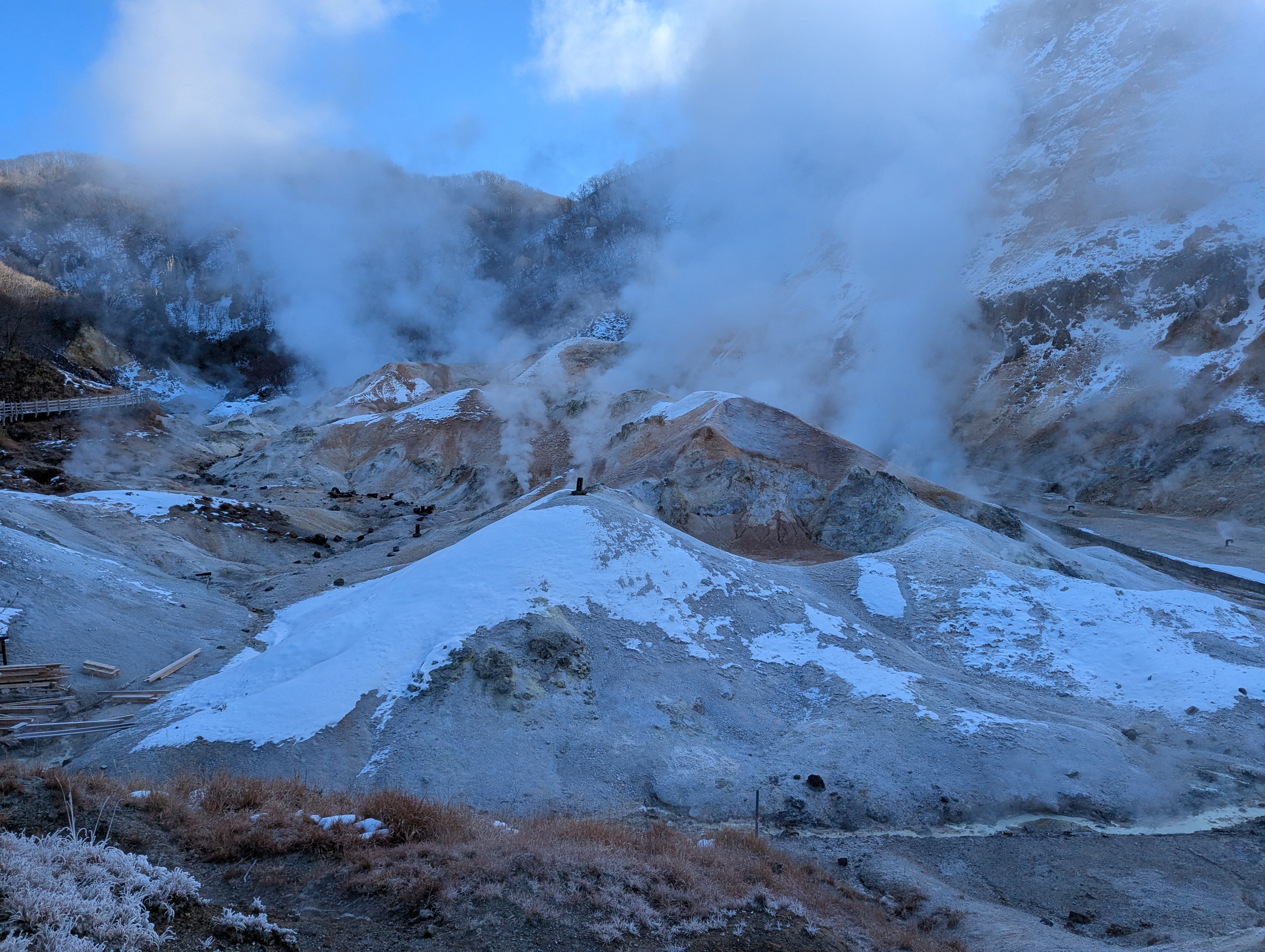
James spent a few days in Sapporo, with my friends joining me on several occasions to help show him around. We spent time enjoying the local cuisine, such as venison soba, soup curry, and Jingisukan, mutton grilled on a convex skillet, famous in Hokkaido. We also hit the major sights, such as the TV tower, clock tower and Sapporo beer museum. We finished off the visit with a trip to my favorite izakaya before seeing each other off. James decided he liked Hokkaido so much that he would be spending the rest of his time in Japan traveling around the island. I couldn’t help but feel happy to have shared my love for Hokkaido with someone else.
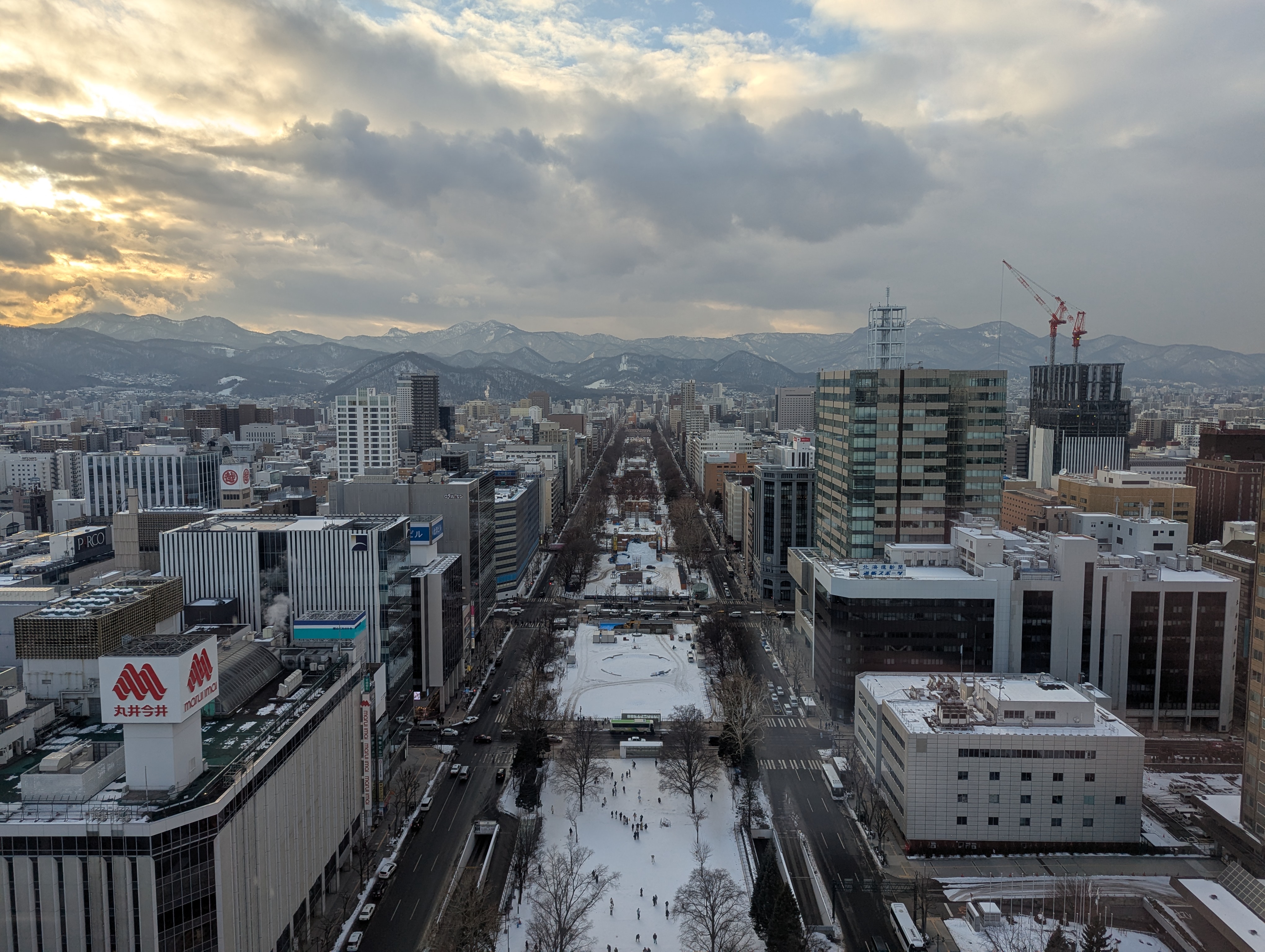
The rest of the month was fairly relaxed compared to the first half. With mostly continuing with classes as usual and unwinding from the eventful winter break, I did go out and buy a second hand guitar, since I found myself beginning to miss playing.
February
The beginning of February continued much the same as the end of the last month. I arranged a night out with a Canadian friend who could speak French. We went out for dinner and spent the entire evening speaking French, as a way for both of us to keep up our practice. His accent was very strong, which proved a fun challenge, there were even parts of our conversation where I found myself pronouncing certain words similar to him.
It was around this time that I started learning Hanafuda, a Japanese card game that makes use of a unique set of cards with various flower patterns on it. The game involves matching sets and making different combinations for points. Hanafuda cards were actually what Nintendo made originally when it was founded in 1889, long before they would get into the business of video games. It was a game I was meaning to learn to play for years, but finally got around to learning in my downtime. I had a chance to teach and play with a few of my friends on several occasions. They all really enjoyed the game as much as I did.
The February also marked the beginning of the famous Sapporo Snow Festival. Odori park at the center of the city is filled with snow sculptures, ranging from just a bit taller than a person, to several stories. The festival was started in the 50s and has since become a staple of the city, attracting visitors from all over Japan and the world. There are community made sculptures, ones sponsored by companies, and the largest being ones built by the Japanese Self Defense Force, officially part of their training exercises. The festival this year had a unique event this year, with a food stall attempting to break the world record for the most curry bread sold in eight hours. This was beaten after only six and a half, when all 11,208 curry breads were sold, taking over as the new world record.
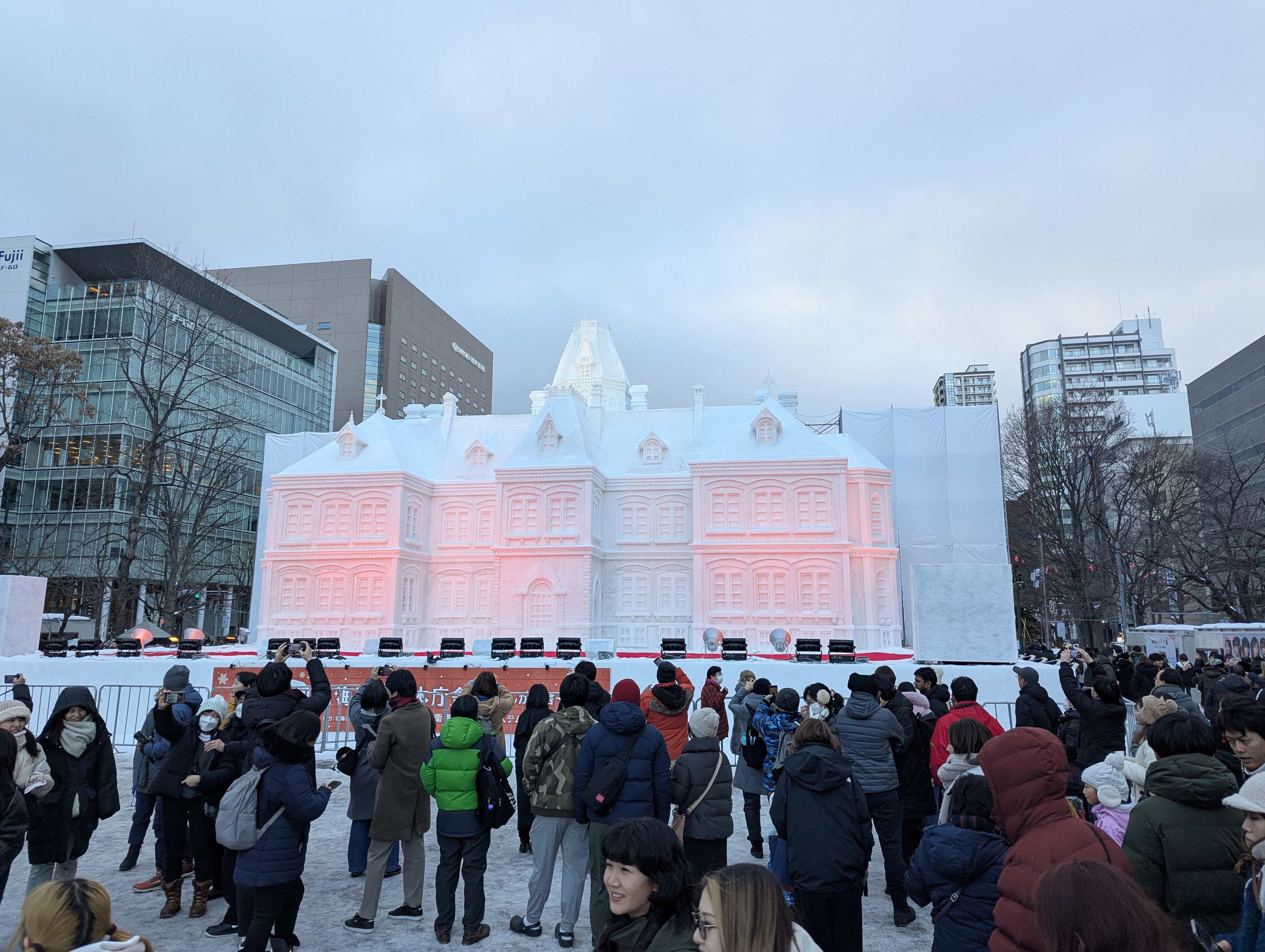
The weekend following the snow festival, I met up with some friends for an overnight onsen trip. We had planned it months in advance as a celebration of one of their birthdays. Eight of us packed into a van and drove south to Lake Shikotsu, a bit over an hour south of Sapporo. We drove over to a little tourism spot where there was an ice festival happening. Large ice structures and tunnels had been constructed from ice formed over metal frames. While it was quite cold, it all the structures were beautiful and the views of the lake were incredible.
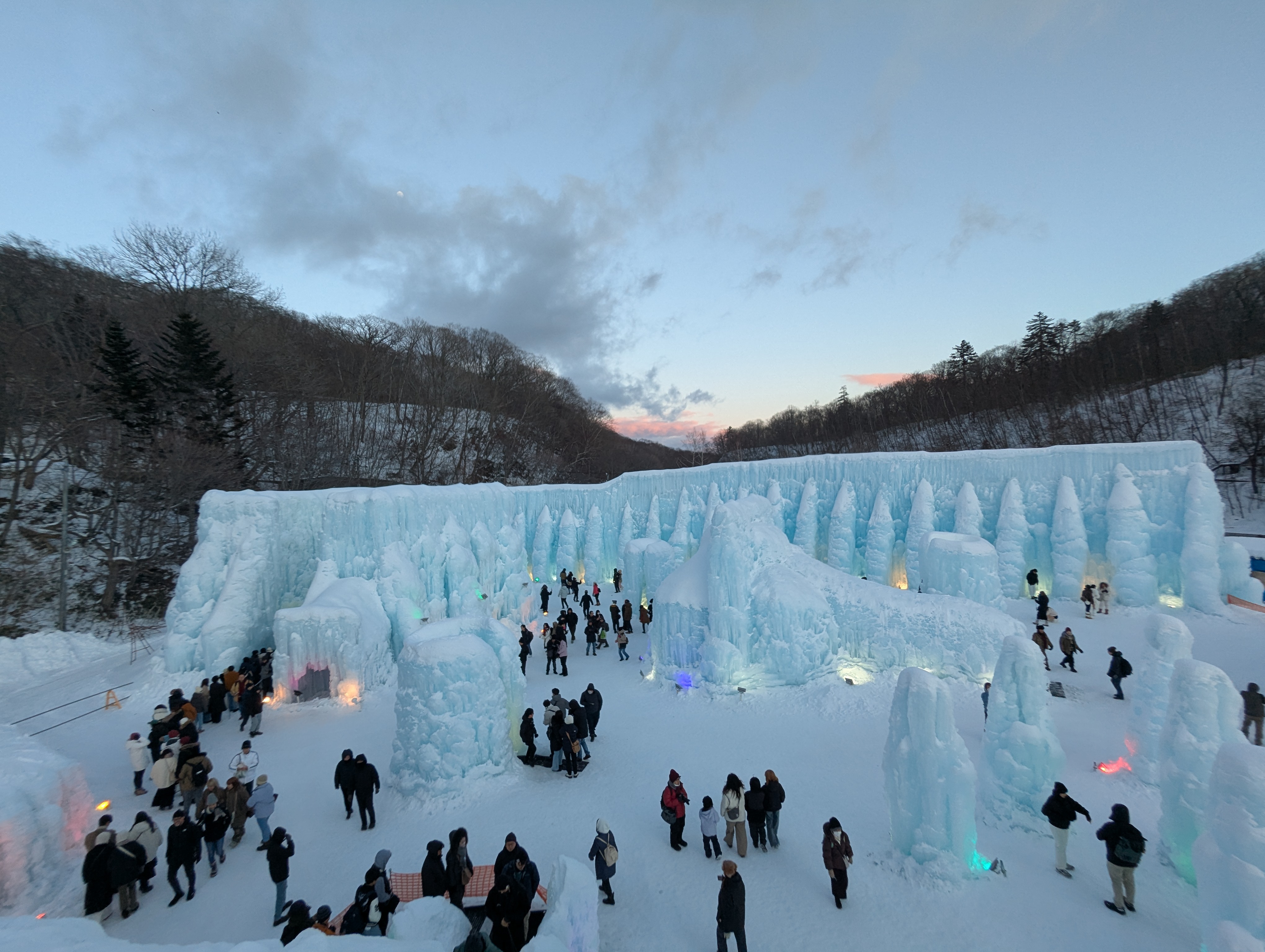
Once we were all sufficiently cold and tired, we drove back to the other side of the lake to check into our hotel. It was small and quiet, at the end of a winding road through the woods, right on the lake. We checked in and picked out our rooms before convening in one to figure out the plan. Having already put money into the hotel and car rental, we weren’t keen to spend money on the quite expensive fancy dinner option. It was about now that we realized our mistake in not picking up things on the way, as the nearest convenience store was a 40-minute drive. Not really having much of a choice besides expensive beer small snacks in the hotel gift shop, we decided that half of us would drive out to grab provisions of cup noodles and drinks. The other half of us held down the fort, playing card games and chatting.
After about a little over an hour, the group reunited and we enjoyed a familiar college meal. After getting some food in us, we changed into our Yukatas, a kind of Japanese bath robe traditionally worn at onsens. We went and hit the baths, enjoying the warm water and cold night air. After a few hours, we dried off and regrouped to play some card games and hang out into the night.
I woke up around six to hit the onsen once again. This time to enjoy the sunset over the lake. My friend and I were the first ones in the bath, but it wasn’t long after that the small bath was completely packed with about 10 more people. We all sat in silence, enjoying the cool morning air and watching one of the nicest sunrises I’d seen. Afterward, we got dressed and checked out before driving back to Sapporo.
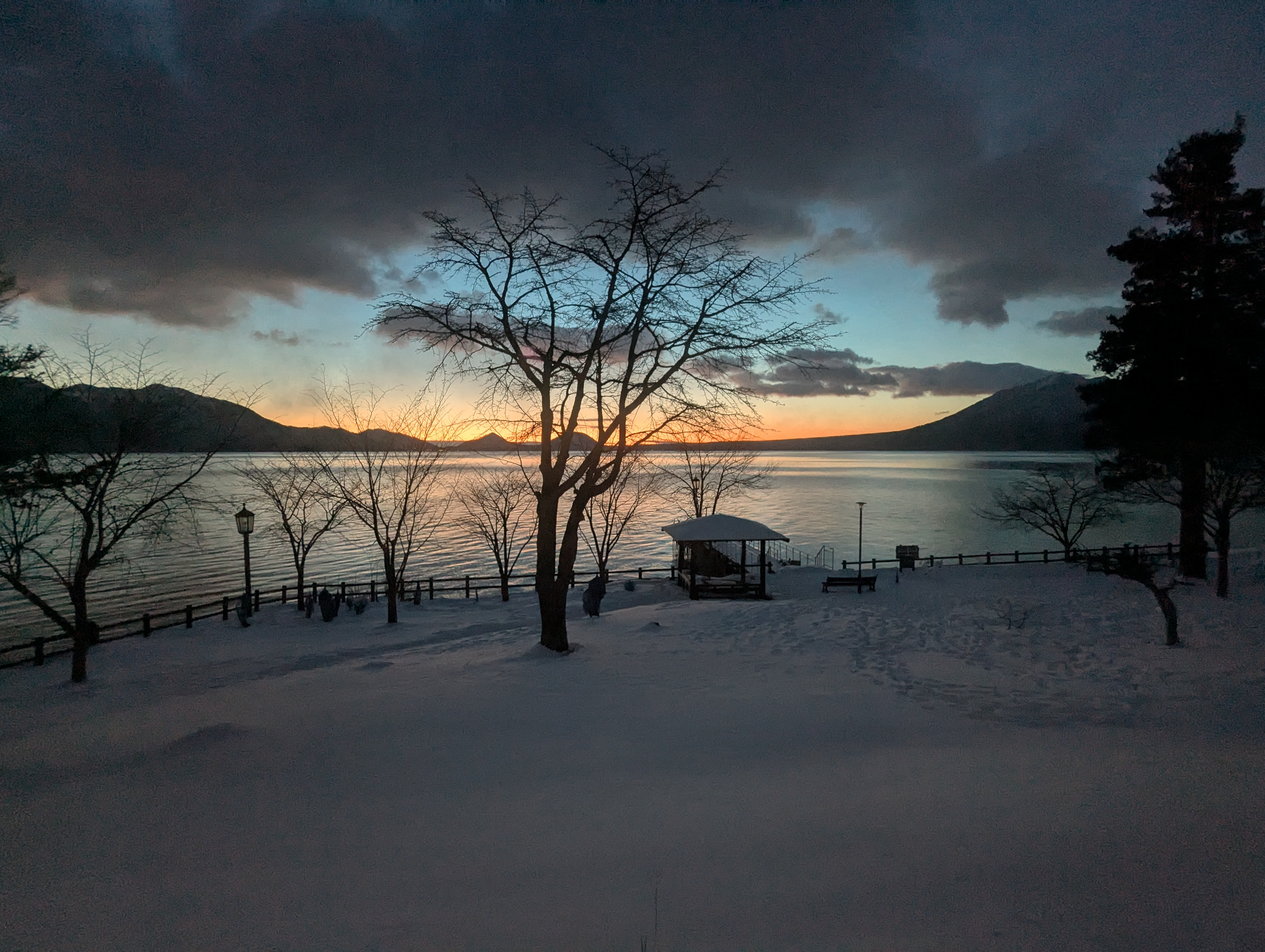
The following week, I had the opportunity to do a lesson at the nearby elementary school. March marks the end of the Japanese school year, and many of the students would be coming to my school in April. Several of the teachers would be heading over to do some fun lessons to the perspective new students, and I was asked to be a part of it. I would be co-teaching with a teacher I have excellent synergy with, so I was pretty excited. It was cool to see the inside of an elementary school for the first time. The students were really energetic and friendly. Our class began shortly after we arrived in the school. The lesson went really well, with me and the teacher having some silly banter to make the kids laugh. I just acted goofy and expressive to great results. I was impressed at how much English they understood at so young. It was a really good experience.
The latter half of the month would mark our next Ministry of Fun event, a trip to Round One stadium outside of town. It’s an impressive arcade and activities complex. For a fee of about ¥2,500 ($16.87 USD as of writing), you get access to “Spocha” for 24 hours. Three floors with numerous activities including free-play arcade machines, rollerblading, mini bowling, darts, table tennis, billiards, air hockey, karaoke, badminton, volley ball, basketball, batting cages, and much more. I spent nearly five hours there, participating in a little bit of everything. It was great fun, particularly having a chance to really move around, especially with everyone getting a bit tired of winter. While I was quite sore the next day, it was definitely worth it.
Around this time, I was having my final lessons with my third year students. They were all very busy with preparing for the high school entrance exams. High school functions a bit differently in Japan to western countries in that it’s not mandatory, but only a fraction of a percent of Japanese choose not to go. Some high schools have specific specialties, like agriculture, industry, nursing and so on. Choosing a high school is an important and stressful part of the lives of Japanese students. For my last lessons with my third years, I decided to bring my guitar into school to play music for them. I’d spent the week before practicing “Green Grass Grows All Around” as played by Pete Seeger. I ended up playing it for a few of my classes to great success. While I’m not terribly good at singing, let along singing and playing guitar at the same time, it was a lot of fun for both me and my students. A moment I had playing and singing in front of all my students sitting on the floor and their desks, circled around me, was something that sticks in my memory.
February capped off its final day with the closing day of my favorite izakaya. It would be shuttering for several months for some major renovations. It was a place I frequented and where I met and had conversations with most native Japanese outside work. After getting some dinner in town with friends, we all headed over to the izakaya. It was busy and everyone was making merry in the small building. We stayed for a few hours, snacking and drinking and enjoying the atmosphere. At one point, some folks with a tuba, banjo, trumpet, and drum did a spontaneous blues concert for everyone. It was a strong end to a place that had meant so much to me. I’ll be eagerly awaiting its reopening in the future.
Ending Thoughts
The past few months have been quite busy, but lots of fun. I think winter hitting slowed down my writing, but as spring rolls in, I’m hoping to keep things rolling at a better pace. I think I’ll save the events of March for the next post, given the length of this one already. Graduation time has come, and it’s been bittersweet to see so many of the students and some of the teachers I’ve been so close with moving on to the next chapters in their life. All the same, I’m excited to be welcoming a new wave of students and teachers and being part of their lives moving forward. I hope adding some links to little cultural things can help provide further reading to some of the things i’ve described. I’ve also made an effort to include more photos. I apologize this took a bit of time to write and there may be the occasional spelling or grammar error, but I hope it helped elucidate all the wonderful things I’ve been up to! Please look forward to my next post!